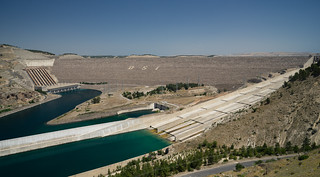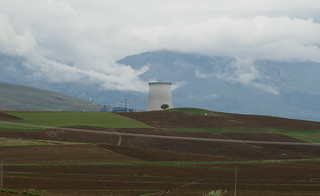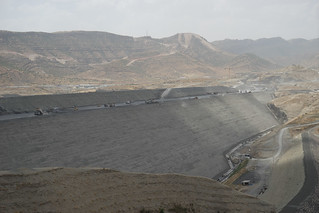In Diyarbakir, we were interviewed by a reporter for an online newspaper associated with Mezopotamya Ekoloji Hareketi, a group working with local municipalities to prevent ecological destruction in Kurdistan. When preparing for the interview, we thought about the questions we might be asked and wrote up some notes.
We figured we would be asked about the overall purpose of our trip, and we boiled it down to 3 major goals:
Also, we thought they’d ask what we have learned about climate change in Turkey. Our answer comes from 3 different sources:
The interview ended up being a bit different than we anticipated. The reporter first asked about what sort of ecological destruction we had seen in Turkey as we rode. This question got us thinking about the areas we had ridden through – mostly we’ve been going through small towns and the countryside where, with the exception of a day or two of forests and the ride along Lake Tuz, it’s been mostly farmland. Whether farming counts as ecological destruction depends on your perspective; one thing David has remarked on many times during this trip is the vastness of the human footprint. Biking through Mesopotamia, we can’t help but mull over human history and the ways the landscape around us has been altered, from megafauna extinctions, to the development of agriculture and permanent human settlements, to the many hydroelectric and irrigation dams built on the Euphrates and Tigris rivers.
We responded that we’d seen a lot of construction – new roads, dams, pipelines, power plants, buildings, transmission lines; but that we didn’t know what degree of destruction they had caused. We did go up the Euphrates – or rather, the Birecik Reservoir, where we saw several drowned villages, which certainly is destruction of a kind. We also visited the Ataturk Dam, which holds back a reservoir bigger than any in the U.S.; there’s no way a dam of that scale didn’t cause considerable ecological destruction.
The rest of the interview/conversation was mostly about dams and politics, two inseparable issues in Turkey. In fact, everything seems to come down to politics, especially in Kurdistan – the southeastern part of the country, where the population is largely Kurdish. While we observed a consistent displeasure across the country regarding government-backed hydropower and nuclear projects, it seems more personal in the southeast: people feel that the government has a policy of taking good things – power, water – from the east and transferring them to the west, leaving behind pollution and destroyed landscapes. We were asked what we thought people in this region should do to preserve their environment in the face of unfavorable governmental policies. It was a question we were not prepared to answer; there is a long history of oppression, violence, and distrust in this part of the country that as outsiders we can only get a glimpse of. We don’t have enough context and local knowledge to offer advice on whether and how to push back against a powerful central government on projects that are a core part of its program.
As we talked, we felt a tension similar to that we’ve been feeling all along on this trip: Turkey is installing more energy capacity – what form should it take? Dams are very unpopular – there are three planned on the Tigris near Diyarbakir alone, one of which would flood a large patch of farms and gardens where most of the produce for the city comes from. If they don’t build those dams, will they build coal or natural gas power plants instead? What local treasures might those destroy, in addition to creating greenhouse gas emissions that affect the whole world? Or could Turkey choose not to build new energy projects? Many environmentalists argue that they don’t improve anybody’s lives and that the energy isn’t necessary. (On the other hand, in the apartment where we are staying in Diyarbakir, the electricity has gone out several times a day – and Turkey’s energy consumption per capita is much lower than the average developed country.)
When we set off across Turkey, we hoped to answer some of these questions. Two thirds of our way across the country, we don’t feel much closer to the answers. Instead, we’ve become more acutely aware of why it is so hard for us to address climate change. For one, environmentalism is intrinsically local, and what is best for a community or region (for example, building natural gas power plants instead of hydropower or nuclear) might not be what is best for the world (since fossil fuel power plants have higher greenhouse gas emissions). Also, climate change is a problem that we all have to work together to solve. Getting the countries of the world to work together seems all the more daunting when you observe how people struggle to work together within national borders, as we’ve witnessed here in Kurdistan where people complain of an oppressive national government and Turkish fighter jets make flyovers several times a day, drowning out conversation.
If anything, this tension between the local and the global, and the personal nature of the anti-dam movements, highlights why we’re doing this trip: to personalize climate change. A dam under construction poised to drown a village that has been inhabited for over 10,000 years (such as Ilisu Dam, which will flood Hasankeyf) is immediate, dramatic, and personal. Right now, it’s hard to show that any particular event – hurricanes in the Philippines, droughts in Turkey or California – is due to climate change, but the science suggests that these kinds of destructive events are likely to become more frequent and intense as the planet warms. In order to inspire action with the same passion we see in the anti-dam movements here, we need to understand how climate change – an abstract, slow-moving, global phenomenon – could ultimately be as locally damaging as a nuclear power plant or dam – perhaps even more so. As we mentioned in our interview, it is our hope that the stories we share will help demonstrate this and move people just a little closer to action.









